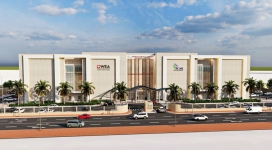The Southern Baptist Convention (SBC) dispatched its first round of disaster units to help Floridians recover from Hurricane Frances, on Sept 7, 2004. While only two dozen units were dispatched in the first round, the SBC announced that it had more than 120 units that are activated and ready to be deployed in other parts of the US.
Several weeks ago, Southern Baptists were on-scene at the wake of Hurricane Charley, as the third largest relief group – after the American Red Cross and the Salvation Army. During the Charley relief, SBC sent several thousand volunteers to man feeding, recovery, shower, water and sleeping shelters. Often, the SBC worked alongside the American Red Cross in loading truckloads of food for those in need.
According to Jim Burton, director of volunteer mobilization for the SBC’s North American Mission Board (NAMB), the newly dispatched units will be working along the eastern corridor of Florida, with some stationed in the Orlando area. With 121 total units standing by, Burton said the SBC and NAMB is working out plans with the Red Cross and with the Florida Baptist Convention.
"This morning we got a taste of Frances here: 40 to 50 mile an hour winds and heavy rains," Burton said from his office in northern Georgia. "The thing that concerns us now is we're getting more and more reports -- especially out of South Carolina -- about tornadoes."
Burton said the needs have yet to be assessed in the areas hardest struck by Frances and Charley. However, Burton expected the relief to be extended to several weeks; Burton took note of the SBC response to Hurricane Isabel in 2003, Hurricane Andrew in 1992 and the Midwestern flooding in 1993 that took months to complete.
"With damage in Florida, Georgia and Alabama, I expect we will surpass that," Burton said of the Frances relief effort. "The storm's size, in terms of being so long and so slow, is what caused the damage. We expect more wind and water damage than from Charley."
According to the Associated Press, Frances caused comparably less damage than did Charley, but its sheer size wreaked havoc across nearly all of Florida, leaving some 6 million residents without electricity. The state’s chief financial officer tom Gallagher estimated that the storm had caused some $2 billion worth of damages; Charley had caused an estimated 15 billion of damages.
With such large needs at hand, Burton explained that units from surrounding states - North Carolina, South Carolina, Tennessee, Virginia Baptist Mission Board, Pennsylvania-South Jersey, New York, Missouri, New Mexico, Kentucky, the Northwest and California - were en route to Florida on Sept. 6. There are also units in four staging sites in Georgia, Alabama and South Carolina, awaiting mobilization.
These volunteers will help with the cleanup and feeding efforts, first and foremost, and will then help the long-term recovery efforts.
"In the initial stage of a disaster, we concentrate more on feeding and clean-up," Burton said. "I would expect us to be involved in long-term recovery in Florida for well over two years."
The NAMB has also said it will be accepting more volunteers throughout the week. Specifically, the NAMB is looking for healthy volunteers who are able to lift some 30-40 pounds, and make a two-week commitment to wherever they are needed; the NAMB said 143 people enlisted from across the States for the sustained volunteer work.
Meanwhile, with the massive clean-up efforts at hand, Floridians and volunteers are watching reports of yet another hurricane en-route toward the Florida coast. Hurricane Ivan, a storm with sustained winds of more than 100 mph, is currently 1,500 miles off shore.
Said Burton: "We're deeply concerned about that. We don't know what it holds."







